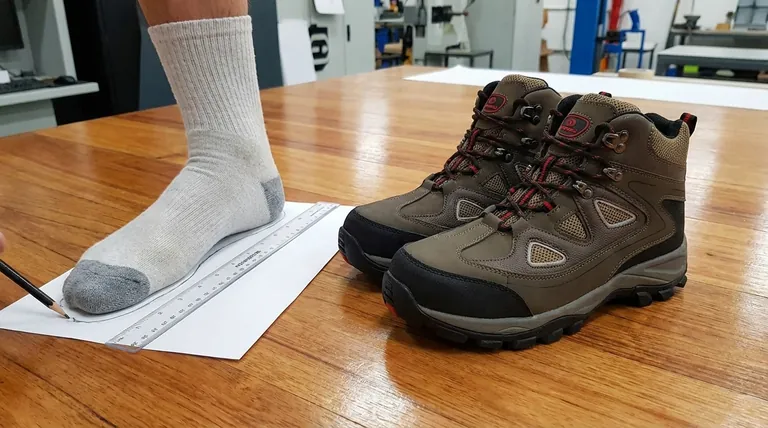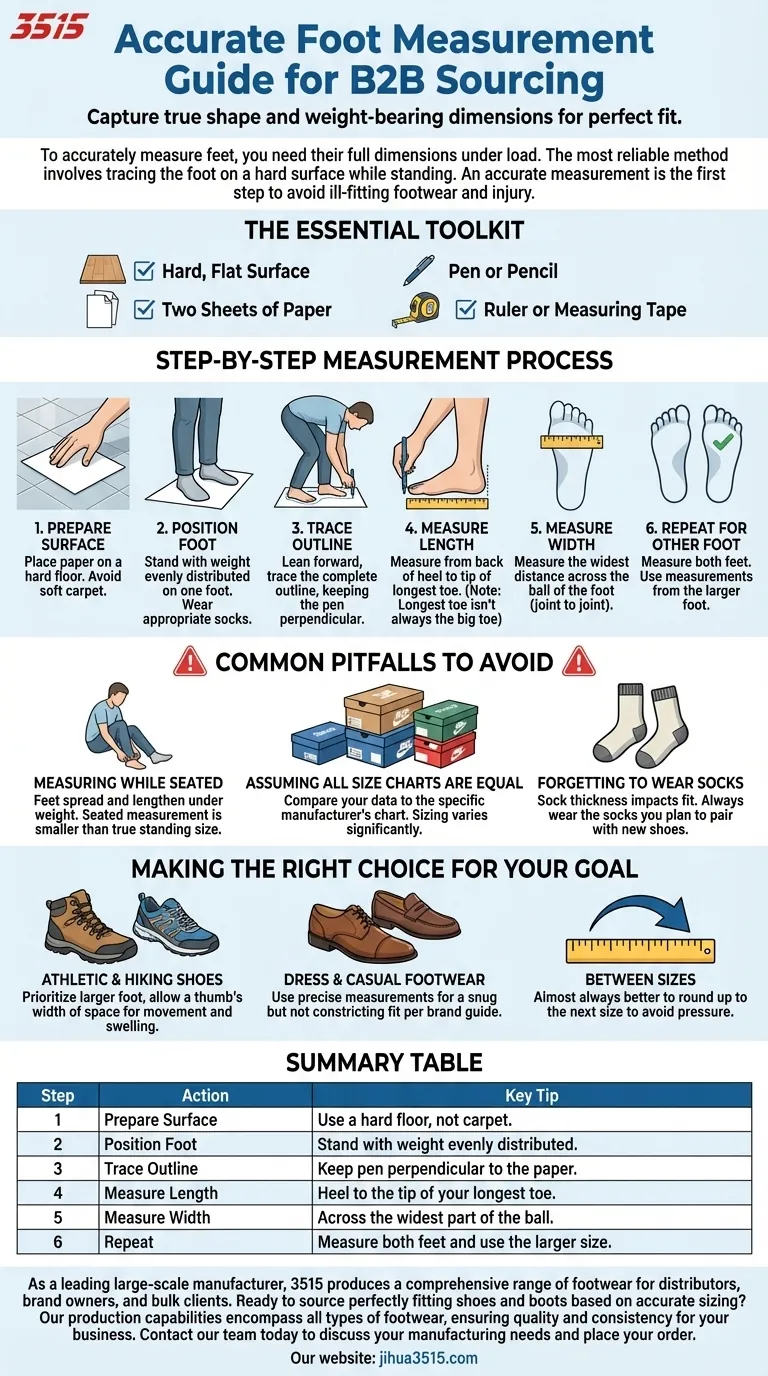To accurately measure your feet at home, you need to capture their full weight-bearing dimensions. The most reliable method involves placing a sheet of paper on a hard surface, standing on it, and tracing the outline of your foot. You then measure the longest distance from your heel to the tip of your longest toe for length, and the widest distance across the ball of your foot for width.
The fundamental goal is not just to find a number, but to capture the true shape and size of your foot under load. An accurate measurement is the critical first step in avoiding the discomfort and potential injury that comes from ill-fitting footwear.

The Essential Toolkit for Measurement
Before you begin, gather a few simple items to ensure you get a precise reading. You don't need any specialized equipment.
What You Will Need
- A hard, flat surface (like a hardwood floor or tile)
- Two sheets of blank paper larger than your feet
- A pen or pencil
- A ruler or measuring tape
The Step-by-Step Measurement Process
Following these steps methodically will provide you with the most reliable length and width measurements. It's best to do this later in the day, as feet naturally swell slightly over time.
Step 1: Prepare Your Surface
Place a sheet of paper on the hard floor. Avoid soft surfaces like carpet, as they can cause an inaccurate tracing.
Step 2: Position Your Foot Correctly
Stand firmly on the paper with one foot. Wear the same type of socks you intend to wear with the shoes you plan to buy. Distribute your weight evenly as if you were standing normally.
Step 3: Trace the Outline
Lean forward slightly to ensure your foot is fully flat. Carefully trace the complete outline of your foot, keeping the pen or pencil as perpendicular to the paper as possible to avoid angled lines.
Step 4: Measure for Length
Use your ruler to measure the distance from the very back of your heel to the tip of your longest toe. Be aware that for many people, the longest toe is not the big toe.
Step 5: Measure for Width
Measure the widest part of your foot. This is typically across the ball of your foot, from the joint of your big toe to the joint of your pinky toe.
Step 6: Repeat for the Other Foot
It is very common for a person's feet to be slightly different sizes. Repeat the entire process for your other foot and use the measurements from the larger of the two.
Common Pitfalls to Avoid
A small mistake in the process can lead to buying the wrong size. Being aware of these common errors is key to getting it right.
Pitfall 1: Measuring While Seated
Never measure your feet while sitting down. Your feet spread and lengthen under your body's weight, so a seated measurement will always be smaller than your true, standing size.
Pitfall 2: Assuming All Size Charts Are Equal
Your millimeter or inch measurement is just data. You must compare this data to the specific size chart provided by the shoe manufacturer you are considering, as sizing can vary significantly between brands.
Pitfall 3: Forgetting to Wear Socks
The thickness of your socks can impact the fit. Always measure while wearing the socks you plan to pair with your new shoes, especially for thicker hiking or winter socks.
Making the Right Choice for Your Goal
With your accurate measurements, you can now interpret them based on the type of footwear you need.
- If your primary focus is athletic shoes or hiking boots: Prioritize the larger foot's measurements and consider a size that allows for a thumb's width of space between your longest toe and the end of the shoe to accommodate movement and swelling.
- If your primary focus is dress shoes or casual footwear: Use your precise measurements to find a snug but not constricting fit according to the brand's size guide.
- If you fall between two sizes: It is almost always better to round up to the next size to avoid pinching and pressure, especially for closed-toe shoes.
Taking a few minutes to measure your feet properly is the single best investment you can make in your daily comfort.
Summary Table:
| Step | Action | Key Tip |
|---|---|---|
| 1 | Prepare Surface | Use a hard floor, not carpet. |
| 2 | Position Foot | Stand with weight evenly distributed. |
| 3 | Trace Outline | Keep pen perpendicular to the paper. |
| 4 | Measure Length | Heel to the tip of your longest toe. |
| 5 | Measure Width | Across the widest part of the ball. |
| 6 | Repeat | Measure both feet and use the larger size. |
As a leading large-scale manufacturer, 3515 produces a comprehensive range of footwear for distributors, brand owners, and bulk clients. Ready to source perfectly fitting shoes and boots based on accurate sizing? Our production capabilities encompass all types of footwear, ensuring quality and consistency for your business. Contact our team today to discuss your manufacturing needs and place your order.
Visual Guide

Related Products
- Safety Footwear Wholesale Manufacturer for Custom OEM/ODM Production
- Premium KPU Injection Athletic Style Safety Shoes
- Wholesale Comfortable Business Casual Shoes Custom Manufacturing
- Wholesale Safety Footwear Manufacturer for Bulk & Custom OEM Orders
- Wholesale Anti-Smash & Puncture-Proof Safety Shoes Custom Manufacturing for Brands
People Also Ask
- Is safety-toe as good as steel toe? Choose the Right Protection for Your Job
- What cultural and environmental considerations are tied to wearing shoes indoors? Balance Hygiene, Tradition, and Foot Health
- How long can you wear safety boots? The Lifespan is Determined by Wear, Not Time
- Is it normal to wear shoes in the house? A Guide to Hygiene, Comfort & Culture
- What are the differences between steel toe, composite toe, and alloy toe Wellington boots? Choose the Right Safety Toe for Your Job



















